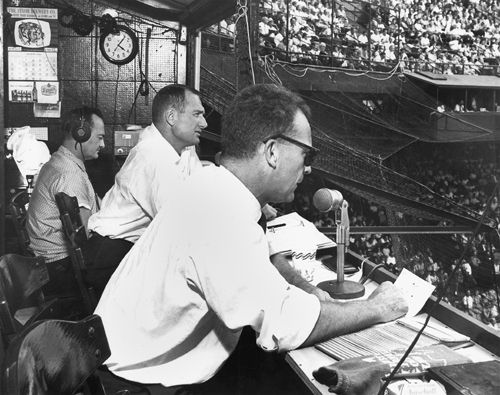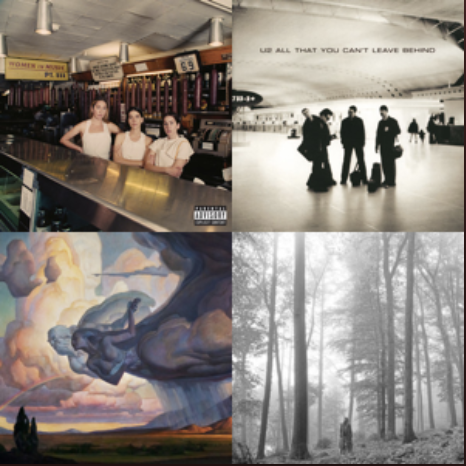We’ve tried something new with the piece. Click here to listen to Laura Tokie read her review of “Ernie.” Below you’ll find the transcript. We hope you enjoy it.
On a rainy Thursday night in June, I took my eighty-five-year-old aunt to the current show at Detroit’s City Theatre.
The show is in its third year, sort of. It hasn’t run continuously for three years. Rather it returns like the weather, in its season, when, as it says in Song of Solomon, “…the winter is past, the rain is over and gone; the flowers appear on the earth; the time of the singing of birds is come, and the voice of the turtle is heard in our land.”
The play was written by Mitch Albom, best known for his book Tuesdays with Morrie. This is his fourth play, titled “Ernie.”
“Ernie.” I imagine that name might be obscure, but my aunt instantly guessed the full identity of the title character. Ernie Harwell, the voice of summer, the voice of the Detroit Tigers for 42 seasons. He began each season with that quote from Song of Solomon, for the last time in 2002, at the age of 84. He died in 2010, and was mourned like royalty, lying in state at the ballfield, more than 10,000 fans paying their respects.
And now a two-man play. A play, an unexpected form. Theatre is by nature collaborative, but Harwell was an old-school broadcaster, calling his innings solo, without a color commentator. This was a part of his special connection with his audience-he was the storyteller, allowing only the sounds of the game to float between his words.
So a play was not the obvious choice, but taking my aunt was. She calls her spare bedroom “the Tiger room.” It’s filled with baseball memorabilia. She’s a lifelong theatregoer too, and as I sat with her, surprised by her response, I realized that telling the story onstage was right.
***
The play is set in the tunnel of Comerica Park, the Detroit Tigers home field. The Old English D sits high above the light bar. Three screens act as a backdrop, and they are put to good use throughout the course of the show, allowing the audience to see pictures and footage of some of the stories mentioned during the play. It is the evening of September 16, 2009: the night that Harwell, diagnosed with terminal cancer, said his last goodbye to the fans. The character Ernie is struggling with the idea of going before the crowd; he feels that all the attention is too much. During a rain delay, a young man, called Boy, appears. Time stops. Boy asks Ernie to share his life story.
At this point, the show seems purely biography dressed in the theatre’s clothes. Not that I minded. His is quite a tale, beginning in Georgia as a writer, becoming a broadcaster in Atlanta, being traded to New York, bearing witness to the rise of Jackie Robinson as the Dodgers broadcaster, then moving across town to the Giants, joining the military and spared heavy combat in World War 2, marriage, children, finding faith, trying his hand at television and other sports before coming to the Tigers, the stories woven together with light stage business between Ernie and Boy.
Beautiful. Touching. My aunt is enjoying herself. But the question lingers–beyond the fact that Harwell liked the idea, why a play?
The answer is hinted at as the show continues, and becomes clear as Ernie tells of a moment from the 1984 World Series: Kirk Gibson’s at-bat versus Goose Gossage in Game 5.
Onstage, Ernie begins with the backstory. This is the right time in the game for an intentional walk, but Gossage thinks he can get Gibson out, can strike him out, because of their history. We watch the video moments unfold – the conference on the mound beween Gossage and his manager, the cut away to Tiger’s manager Sparky Anderson in the dugout hollering at Gibson, “he don’t wanna walk you.”
Ernie and the kid repeat it, “he don’t wanna walk you… he don’t wanna walk you,” just like Sparky. You can feel the crowd in the theatre responding. Are people shaking their fingers, mouthing the words? I don’t know, because my aunt can no longer contain herself. She tells me she watched this same footage of the game in Cooperstown, on a huge screen, amazing, she says, her eyes lit by the memory as much as by the stage. She’s not whispering and no one is shushing her because it is amazing. It is elevated story, it is shared story. There’s the wind-up. And the pitch. It’s a long drive to right, the call begins, and we are stirred, thrilled at the sight of Gibson’s arms in the air as he rounds first. The 5:30 Thursday night crowd in the theatre is on the verge of erupting.
This is why theatre is the perfect medium to tell this story. As Boy says, quoting from Tennyson’s Ulysses, “I am a part of all that I have met.” Theatre is a collaborative medium, and this isn’t purely biography. “Ernie” is a story of the stories we share.
** “Ernie” | Written by Mitch Albom, directed by Tony Caselli, featuring Timothy “TJ” Corbett as Boy and Will David Young as Ernie Harwell.




